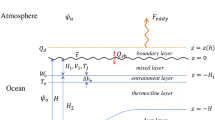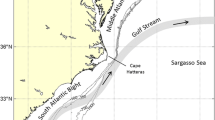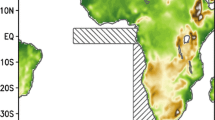Abstract
This paper explores the role of synoptic eddy feedback in the air-sea interaction in the North Atlantic region, particularly the interaction between the North Atlantic Oscillation (NAO) and the North Atlantic sea surface temperature anomalies (SSTA) tripole. A linearized five-layer primitive equation atmospheric model with synoptic eddy and low-frequency flow (SELF) interaction is coupled with a linearized oceanic mixed-layer model to investigate this issue. In this model, the “climatological” storm track/activity (or synoptic eddy activity) is characterized in terms of spatial structures, variances, decay time scales and propagation speeds through the complex empirical orthogonal function (CEOF) analysis on the observed data, which provides a unique tool to investigate the role of synoptic eddy feedback in the North Atlantic air–sea coupling. Model experiments show that the NAO-like atmospheric circulation anomalies can produce tripole-like SSTA in the North Atlantic Ocean, and the tripole-like SSTA can excite a NAO-like dipole with an equivalent barotropic structure in the atmospheric circulation, which suggests a positive feedback between the NAO and the SSTA tripole. This positive feedback makes the NAO/SSTA tripole-like mode be the leading mode of the coupled dynamical system. The synoptic eddy feedback plays an essential role in the origin of the NAO/SSTA tripole-like leading mode and the equivalent barotropic structure in the atmosphere. Without synoptic eddy feedback, the atmosphere has a baroclinic structure in the response field to the tripole-like SSTA forcing, and the leading mode of the dynamic system does not resemble NAO/SSTA tripole pattern.













Similar content being viewed by others
References
Barsugli JJ, Battisti DS (1998) The basic effects of atmosphere–ocean thermal coupling on midlatitude variability. J Atmos Sci 55:477–493
Bjerknes J (1964) Atlantic air–sea interaction. Adv Geophys 10:1–82
Bretherton CS, Battisti (2000) An interpretation of the results from atmospheric general circulation models forced by the time history of the observed sea surface temperature distribution. Geophys Res Lett 27:767–770
Cayan DR (1992) Latent and sensible heat flux anomalies over the oceans: Driving the sea surface temperature. J Phys Oceanogr 22:859–881
Czaja A, Frankignoul C (2002) Observed impact of Atlantic SST anomalies on the North Atlantic Oscillation. J Clim 15:606–623
Czaja A, Robertson AW, Huck T (2003) The role of Atlantic ocean-atmosphere coupling in affecting North Atlantic Oscillation variability. In: Hurrell JW, Kushnir Y, Visbeck M (eds) The North Atlantic Oscillation: climate significance and environmental impact. Geophys Monogr Ser 134:147–172
Deser C, Blackmon ML (1993) Surface climate variations over the North Atlantic Ocean during winter: 1900–1989. J Climate 6:1743–1753
Deser C, Timlin M (1997) Diurnal and semidiurnal variations of the surface wind field over the tropical Pacific Ocean. J Clim 11:1730–1748
Frankignoul C, Kestenare E (2002) The surface heat flux feedback. Part I: Estimates from observations in the Atlantic and the North Pacific. Clim Dyn 19:633–647
Frankignoul C, Czaja A, and L’Heveder B (1998) Air–sea feedback in the North Atlantic and surface boundary conditions for ocean models. J Clim 11:2310–2314
Goodman J, Marshall J (1999) A model of decadal middle-latitude atmosphere–ocean coupled modes. J Clim 12:621–641
Hoerling MP, Hurrell JW, Xu T (2001) Tropical origins for recent North Atlantic climate change. Science 292:90–92
Hurrell JW (1995) Decadal trends in the North Atlantic Oscillation: Regional temperatures and precipitation. Science 269:676–679
Hurrell JW, Kushnir Y, Ottersen G, Visbeck M (2003) An overview of the North Atlanic Oscillation. In: Hurrell JW, Kushnir Y, Ottersen G, Visbeck M (eds) The North Atlantic Oscillation: climate significance and environmental impact. Geophys Monogr Ser 134:1–35
Jin FF, Pan LL, Watanabe M (2006a) Dynamics of synoptic eddy and low-frequency flow (SELF) interaction. Part I: A dynamical closure. J Atmos Sci 63:1677–1694
Jin FF, Pan LL, Watanabe M (2006b) Dynamics of synoptic eddy and low-frequency flow (SELF) interaction. Part II: A theory for low-frequency modes. J Atmos Sci 63:1695–1708
Kalnay E et al (1996) The NCEP/NCAR 40-year reanalysis project. Bull Amer Meteor Soc 77:437–470
Kimoto M, Jin FF, Watanabe M, Yasutomi N (2001) Zonal-eddy coupling and a neutral mode theory for the Arctic Oscillation. Geophys Res Lett 28:737–740
Kondo J (1975) Air–sea bulk transfer coefficients in diabatic conditions. Bound Layer Meteor 9:91–112
Kushnir Y, Held IM (1996) Equilibrium atmospheric response to North Atlantic SST anomalies. J Clim 9:1208–1220
Kushnir Y, Lau NC (1992) The general circulation model response to a North Pacific SST anomaly: dependence on timescale and pattern polarity. J Clim 5:271–283
Kushnir Y, Robinson WA, Blade I, Hall NMJ, Peng S, Sutton RT (2002) Atmospheric GCM response to extratropical SST anomalies: synthesis and evaluation. J Clim 15:2233–2256
Lanzante JR (1984) A rotated eigenanalysis of the correlation between 700 mb heights and sea surface temperatures in the Pacific and Atlantic. Mon Wea Rev 112:2270–2280
Latif M, Barnett TP (1994) Causes of decadal climate variability in the North Pacific/North Atlantic sector. Science 266:634–637
Latif M, Arpe K, Roeckner E (2000) Oceanic control of decadal North Atlantic sea level pressure variability in winter. Geophys Res Lett 27:727–730
Levitus S, Boyer TP (1994) World Ocean Atlas 1994, Temperature, NOAA Atlas NESDIS 4: 411
Mehta VM, Suarez MJ, Manganello J, Delworth TL (2000) Predictability of multiyear to decadal variations in the North Atlantic Oscillation and associated Northern Hemisphere climate variations: 1959–1993. Geophys Res Lett 27:121–124
Miller AJ, Cayan DR, Barnett TP, Graham NE, Oberhuber JM (1994) Interdecadal variability of the Pacific Ocean: model response to observed heat flux and wind stress anomalies. Clim Dyn 9:287–302
Pan LL (2003) A study of dynamic mechanisms of Annular Modes, PhD dissertation, University of Hawaii, p 194
Pan LL (2005) Observed positive feedback between the NAO and the North Atlantic SSTA tripole. Geophys Res Lett 32:L06707. doi:10.1029/2005GL022427
Pan LL, Jin FF (2005) Seasonality of synoptic eddy feedback and the AO/NAO. Geophys Res Lett 32:L21708. doi:10.1029/2005GL024133
Pan LL, Jin FF, Watanabe M (2006) Dynamics of synoptic eddy and low-frequency flow (SELF) interaction. Part III: Baroclinic model results. J Atmos Sci 63:1709–1725
Peng S, Robinson WA (2001) Relationships between atmospheric internal variability and the responses to an extratropical SST anomaly. J Clim 14:2943–2959
Peng S, Whitaker JS (1999) Mechanisms determining the atmospheric response to mid-latitude SST anomalies. J Clim 12:1393–1408
Peng S, Mysak LA, Ritchie H, Derome J, Dugas B (1995) The differences between early and midwinter atmospheric responses to sea surface temperature anomalies in the northwest Atlantic. J Clim 8:137–157
Peng S, Robinson WA, Hoerling MP (1997) The modeled atmospheric response to midlatitude SST anomalies and its dependence on background circulation states. J Clim 10:971–987
Peng S, Robinson WA, Li S (2003) Mechanisms for the NAO responses to the North Atlantic SST tripole. J Clim 16:1987–2004
Robertson AW, Mechoso CR, Kim YJ (2000) The influence of Atlantic sea surface temperature anomalies on the North Atlantic Oscillation. J Clim 13:122–138
Robinson WA (2000) Review of WETS—the workshop on extra-tropical SST anomalies. Bull Amer Meteor Soc 81:567–577
Rodwell MJ, Rowell DP, Folland CK (1999) Oceanic forcing of the wintertime North Atlantic oscillation and European climate. Nature 398:320–323
Sutton RT, Allen MR (1997) Decadal predictability of North Atlantic sea surface temperature and climate. Nature 388:563–567
Ting MF (1991) The stationary wave response to a midlatitude SST anomaly in an idealized GCM. J Atmos Sci 47:2546–2566
Visbeck M, Chassignet MEP, Curry RG, Delworth TL, Dickson RR, and Krahmann G (2003) The ocean’s response to North Atlantic Oscillation variability. In: Hurrell JW, Kushnir Y, Ottersen G, Visbeck M (eds) The North Atlantic Oscillation: climate significance and environmental impact. Geophys Monogra Ser 134:113–146
Wallace JM, Gutzler DS (1981) Teleconnection in the geopotential height field during the Northern Hemisphere winter. Mon Wea Rev 109:784–812
Wallace JM, Jiang QR (1987) On the observed structure of the interannual variability of the atmosphere/ocean climate system. In: Cattle H (ed) Atmosperic and oceanic variability. R Meteor Soc, pp 17–43
Wallace JM, Smith C, Jiang Q (1990) Spatial patterns of atmosphere–ocean interaction in the northern witner. J Clim 3:990–998
Watanabe M, Kimoto M (1999) Tropical-extratropical connection in the Atlantic atmosphere–ocean variability. Geophys Res Lett 26:2247–2250
Watanabe M, Kimoto M (2000) Ocean atmosphere thermal coupling in the North Atlantic: a positive feedback. Q J R Meteor Soc 126:3343–3369
Woodruff SD, Slutz RJ, Jenne RL, Steurer P (1987) A comprehensive ocean-atmosphere data set. Bull Am Meteorol Soc 68:1239–1250
Xie SP, Carton JA (2004) Tropical Atlantic Variability: Patterns, mechanisms, and impacts. In: Wang C, Xie SP, Carton JA (eds) Earth climate: the ocean–atmosphere interaction. AGU Geophys Monogr 147:121–142
Xie SP, Tanimoto Y (1998) A pan-Atlantic decadal climate oscillation. Geophys Res Lett 25:2185–2188
Yanai M, Tomita T (1997) Seasonal and interannual variability of atmospheric heat sources and moisture sinks as determined from NCEP-NCAR reanalysis. J Clim 11:463–482
Acknowledgments
This research is supported by NOAA and NSF grants. Part of this research had been finished during the author’s PhD dissertation study, and the author is thankful for stimulating discussions with Drs. F.-F. Jin, M. Watanabe, S.-P. Xie, K. Hamilton, B. Qiu, B. Wang, and Tim Li. The manuscript is edited by Ms. D. Henderson. SOEST contribution number is 7015.
Author information
Authors and Affiliations
Corresponding author
Appendix-The quasi-geostropic model
Appendix-The quasi-geostropic model
The quasi-geostrophic (QG) model mentioned in the Sect. 3 is a linearized two-layer model in middle latitude. It starts from the QG potential vorticity equation,
where P denotes potential vorticity, ψ means streamfunction, J represents Jacobi term and F refers to the forcing term (e.g., linear damping). If we separate potential vorticity P into three parts: climatological basic state \({\bar{P}_{c},}\) low-frequency anomaly \({\bar{P}_{a},}\) and high frequency synoptic eddy P′, then the low-frequency anomaly of \({\bar{P}_{a}}\) can be written as
where \({\overline{{J({\psi}^{\prime},{P}^{\prime})}} |_{a}}\) is related to synoptic eddy forcing. Assume the climatological streamfunction
where C denotes a constant, and y represents the axis of meridional direction. The equation related to zonal-mean zonal wind anomaly can be written as
where “[]” represents the zonal mean. For simplicity, the “[]” is dropped in the following equations, but the equations are still written in terms of zonal-mean sense.
The two-layer QG model can be written as
where the lower-level and upper-level potential vorticity in pressure coordinate can be expressed as
where f 0 denotes Coriolis parameter, σ is the static stability parameter, and Δp represents the pressure difference of the two layers.
The forcing term includes the linear damping related to potential vorticity and external heat forcing F T related to temperature, therefore,
where d 1 and d 2 are linear friction coefficients for lower and upper levels. d T denotes thermal damping coefficient.
Combining Eqs. (A5), (A6), (A9) and (A10), we have,
If steady state is assumed and adding (A11) and (A12) together, the following relationship can be obtained,
Letting
Eq. (A13) changes to
therefore,
where B 0, B 1 and B 2 are any constants and x and yrepresent zonal and meridional axes. For the zonal symmetric case, B 1 equals to zero. Taking the derivative in meridional direction to (A16),
where u a1 and u a2 are the zonal-mean zonal wind at lower and upper layers, \({F_{{ey}} = \frac{{\partial F_{e}}}{{\partial y}}.}\) Since u a1 is zero if the lower level is at earth surface, B 2 can be zero or d 2 u a2 − F ey , and d 2 u a2 − F ey is not a valid solution; therefore, B 2 must be zero. The relationship between the zonal-mean zonal wind at lower and upper layers can be derived,
which is used as Eq. (14) in Sect. 3. The u a1 and u a2 have opposite signs when synoptic forcing equals zero and it has a baroclinic structure in the vertical. If the synoptic eddy forcing has a positive feedback on mean flow and it is strong enough, u a1 and u a2 can have the same sign and have an equivalent barotropic structure in the vertical. This argument is also applicable to stationary wave and zonal flow interaction.
Rights and permissions
About this article
Cite this article
Pan, LL. Synoptic eddy feedback and air–sea interaction in the North Atlantic region. Clim Dyn 29, 647–659 (2007). https://doi.org/10.1007/s00382-007-0256-7
Received:
Accepted:
Published:
Issue Date:
DOI: https://doi.org/10.1007/s00382-007-0256-7




